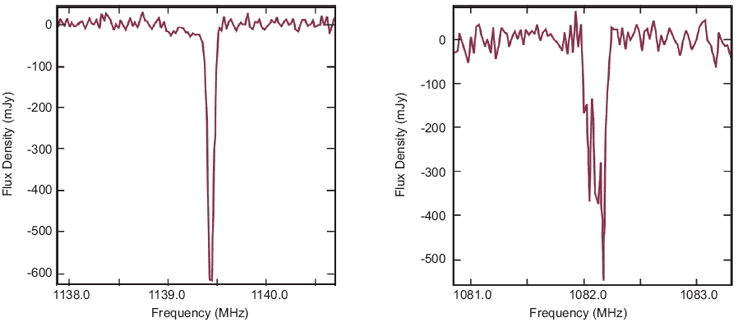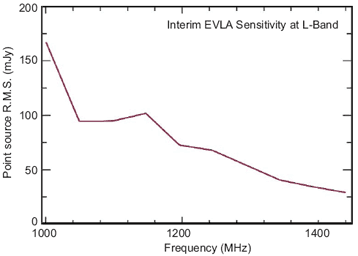NRAO eNews
October 2008 • Vol. 1, Iss. 5
- The Expansion of Supernova Remnant G21.5–0.9: Is PSR J1833–1034 the Youngest Pulsar?
- Discovery of a Small Group Driving the Evolution of an Edge-On Spiral Galaxy
- Cosmic Rays and the Magnetic Field in the Nearby Starburst Galaxy NGC 253
- Neutral Hydrogen Clouds in the M81/M82 Group
- ALMA Project Progress
- North American ALMA Science Center
- The ALMA Spectral Line Catalog
- The Birth and Feedback of Massive Stars, Within and Beyond the Galaxy: The NAASC Science Workshop for 2008
- Current Status
- VLA Configuration Schedule, Proposals, and Scheduling
- VLBA and HSA Proposals and Scheduling
- Global cm VLBI Proposals
- VLA and EVLA Spectral Line Observations Below 1200 MHz
- Status of Observing with the Transition Array
- VLBA Sensitivity Upgrade Project
- First 3mm Science Observations with the GBT and MUSTANG Call for Proposals
- The GBT Dynamic Scheduling System Update
- Progress on the Ka-Band Focal Plane Array for the GBT
- Opportunities for University-Led Technical Development Projects in Green Bank
- New NRAO Website Debuts
- The NRAO at the American Astronomical Society and American Association for the Advancement of Science Meetings
- Call for GBT Shared-Risk MUSTANG Proposals
- Large Proposals to Use NRAO Telescopes
- Chris Carilli Appointed Observatory Chief Scientist
- Eleventh Synthesis Imaging Workshop
- 2008 Grote Reber Medal Awarded to Sandy Weinreb
- NRAO Participates in the BEYA Conference
- NRAO Business Managers Meet in Chile
- NRAO Library News
- Past Issues
- Contact the Editor
- Subscribe
- More Information
NRAO Newsletter • April 2008 • Issue 115
VLA and EVLA Spectral Line Observations Below 1200 MHz
Test observations below 1200 MHz have recently been carried out with the EVLA to assess the feasibility of pursuing spectral-line observations for redshifted HI 21cm or other spectral-line transitions at frequencies where the VLA has severe limitations and/or simply cannot observe.
We have observed two known HI 21cm absorbers, one at z=0.2467 (~1139 MHz) and the other at z=0.3127 (~1082 MHz). Each target was observed for about 45 minutes in B configuration using bandwidths of 3.125 MHz with 127 spectral channels. Both VLA and EVLA antennas (a total of 26) were used for the source at 1139 MHz. The inclusion of the VLA antennas in these observations was possible because the frequency falls within one of the “good VLA frequency windows” (see Figure 4 in EVLA Memo #119 for the sensitivity of the VLA between 1100 and 1225 MHz). The source at 1082 MHz, however, was observed using only the EVLA antennas (total of 13), because the VLA antennas cannot be tuned to frequencies below 1100 MHz.

Figure 1. The HI 21 cm absorption line toward the source PKS 1413+135 at z=0.25 with the EVLA+VLA. |
Figure 2. The HI 21 cm absorption line toward the source PKS 1127-145 at z=0.31 with the EVLA. |
Figures 1 and 2 show the HI absorption spectra of the sources at 1139 and 1082 MHz, with rms noise values of 4.7 and 10 mJy, respectively. We note that sensitivities below 1200 MHz will improve dramatically when the final L-Band receivers are installed through 2009.

Figure 3. The point source rms values for L-Band frequencies between 1000 and 1440 MHz.
Figure 3 shows a representation of the point source rms values obtained by observing a blank field every 5 MHz between 1000 and 1200 MHz. Values obtained at 1350 and 1440 MHz are also included for comparison purposes. The observations were carried out at night time with ten EVLA antennas in CnB configuration. The imaged bandwidth at each frequency setting is 24 kHz and the integration time is 100 sec. It should be noted that for observations below 1200 MHz, only IF pair B and D can be used at this time. Furthermore, we note that the polarization performance below 1200 MHz is severely compromised, with the polarization impurity reaching 40 percent at 1 GHz.
These test observations show that successful observations are possible with the EVLA at frequencies that are believed to be dominated by RFI due to aeronautical navigation transponders, at least in A and B configurations. As this RFI is more evident on the shorter spacings, as well as at day-time hours, more tests will be carried out at various hours of the day and in C and D configurations to fully assess the limitations on astronomical observing due to these transmissions. We expect that daytime observations at these frequencies may be much more difficult.
This new 1.0-1.2 GHz capability on the EVLA is now available for users, and NRAO will consider exploratory proposals to use it in the current configuration through the end of D configuration, September 15, 2008. Please ensure that any proposals are labeled as Rapid Response—Exploratory Time. Any further information to supplement that given above will be posted at the EVLA returns web page. Potential users are advised that these are “shared risk” observations. We cannot guarantee success, especially for daytime observations that might be severely affected by RFI, but we will provide reasonable assistance. Note that proposals for A configuration should be submitted as usual at the June 2, 2008 deadline.
Technical questions about observing below 1200 MHz should be directed to E. Momjian at emomjian@nrao.edu. For information about the special call for exploratory proposals to use the new tuning capabilities please contact C. Chandler at cchandle@nrao.edu.
E. Momjian, R. Perley, C. Chandler
